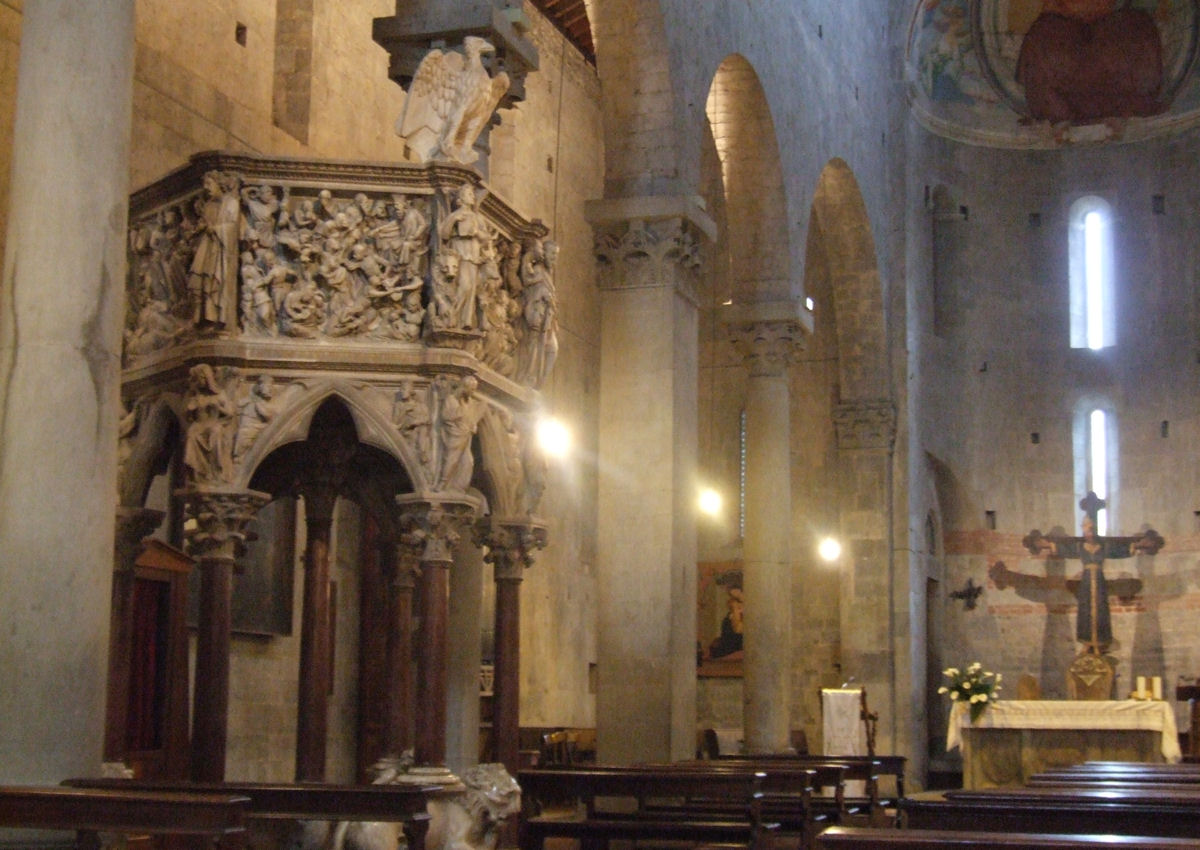Pieve di Sant'Andrea, Pistoia on:
[Wikipedia]
[Google]
[Amazon]

 Sant'Andrea (''Pieve di Sant'Andrea'') is a church in
Sant'Andrea (''Pieve di Sant'Andrea'') is a church in
Page at Diocese of Pistoia website
Sant'Andrea Apostolo Website
{{DEFAULTSORT:Andrea Pistoia
Pistoia
Pistoia (, is a city and ''comune'' in the Italian region of Tuscany, the capital of a province of the same name, located about west and north of Florence and is crossed by the Ombrone Pistoiese, a tributary of the River Arno. It is a typi ...
, Tuscany
Tuscany ( ; it, Toscana ) is a Regions of Italy, region in central Italy with an area of about and a population of about 3.8 million inhabitants. The regional capital is Florence (''Firenze'').
Tuscany is known for its landscapes, history, art ...
, central Italy
Italy ( it, Italia ), officially the Italian Republic, ) or the Republic of Italy, is a country in Southern Europe. It is located in the middle of the Mediterranean Sea, and its territory largely coincides with the homonymous geographical re ...
that served as a pieve
In the Middle Ages, a pieve (, ; la, plebe, link=no; plural ''pievi'') was a rural church with a baptistery, upon which other churches without baptisteries depended.
The Italian word ''pieve'' is descended from Latin ''plebs'' which, after t ...
or place that congregations from surrounding village churches use for baptism
Baptism (from grc-x-koine, βάπτισμα, váptisma) is a form of ritual purification—a characteristic of many religions throughout time and geography. In Christianity, it is a Christian sacrament of initiation and adoption, almost inv ...
. It is dedicated to St. Andrew the Apostle, and includes the famous Pulpit of Sant' Andrea by Giovanni Pisano
Giovanni Pisano (c. 1250 – c. 1315) was an Italian sculptor, painter and architect, who worked in the cities of Pisa, Siena and Pistoia. He is best known for his sculpture which shows the influence of both the French Gothic and the Ancient Rom ...
. The church probably dates from as early as the 8th century, though in a smaller size. In the 12th century it was extended in length.
The façade shows the typical bichrome marble decoration of the Pistoiese Romanesque style, executed in the mid-12th century by Gruamonte and his brother Adeodatus, who was also responsible for the sculptures and for the portal's architrave
In classical architecture, an architrave (; from it, architrave "chief beam", also called an epistyle; from Greek ἐπίστυλον ''epistylon'' "door frame") is the lintel or beam that rests on the capitals of columns.
The term can ...
. The latter depicts the "Journey of the Magi", a rare theme whose use here derives from the fact that the church was located on the Via Francigena The Via Francigena () is an ancient road and pilgrimage route running from the cathedral city of Canterbury in England, through France and Switzerland, to Rome and then to Apulia, Italy, where there were ports of embarkation for the Holy Land. It w ...
, by which, in the Middle Ages, the pilgrims reached Rome
, established_title = Founded
, established_date = 753 BC
, founder = King Romulus (legendary)
, image_map = Map of comune of Rome (metropolitan city of Capital Rome, region Lazio, Italy).svg
, map_caption ...
from France
France (), officially the French Republic ( ), is a country primarily located in Western Europe. It also comprises of Overseas France, overseas regions and territories in the Americas and the Atlantic Ocean, Atlantic, Pacific Ocean, Pac ...
. The decorated capitals are by a Master Henry, while the small statue of St. Andrew in the lunette
A lunette (French ''lunette'', "little moon") is a half-moon shaped architectural space, variously filled with sculpture, painted, glazed, filled with recessed masonry, or void.
A lunette may also be segmental, and the arch may be an arc take ...
over the portal is reminiscent of Giovanni Pisano's style.
In the late 15th century the upper façade was finished and the central nave was vaulted. The frescoes in the apse date to 1506, executed by Bernardino del Signoraccio
Bernardino del Signoraccio or Signoracci (active first three decades of 16th century) was an Italian painter of the Renaissance period, active in Tuscany.
Biography
He was the father of the painter Fra Paolino da Pistoia. Bernardino painted in t ...
. Today only the central part, with the ''Father supported by Four Angels'', survives. The altars in the aisles were added in the 17th century, with paintings by artists such as Cristofano Allori
Cristofano Allori (17 October 1577 – 1 April 1621) was an Italian painter of the late Florentine Mannerist school, painting mostly portraits and religious subjects. Allori was born at Florence and received his first lessons in painting from his ...
, Alessio Gimignani
Alessio is a mostly Italian male name, Italian form of Alexius.
Individuals with the given name Alessio
* Alessio Ascalesi (1872–1952), Italian cardinal
*Alessio Boni (born 1966), Italian actor
*Alessio Cerci (born 1987), Italian footballer
* ...
, and Girolamo Scaglia
Girolamo Scaglia (1620 – 1686) was an Italian painter of the Baroque period. He was born in Lucca
Lucca ( , ) is a city and ''comune'' in Tuscany, Central Italy, on the Serchio River, in a fertile plain near the Ligurian Sea. The city has ...
.
External links
Page at Diocese of Pistoia website
Sant'Andrea Apostolo Website
{{DEFAULTSORT:Andrea Pistoia
Andrea
Andrea is a given name which is common worldwide for both males and females, cognate to Andreas, Andrej and Andrew.
Origin of the name
The name derives from the Greek word ἀνήρ (''anēr''), genitive ἀνδρός (''andrós''), that ref ...
8th-century establishments in Italy
Romanesque architecture in Pistoia